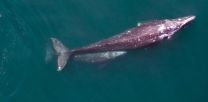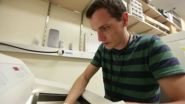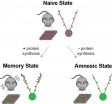(Press-News.org) One recent spring day, John Durban, a NOAA Fisheries marine mammal biologist, stood on the California coast and launched an unmanned aerial vehicle into the air. The hexacopter--so called because it has six helicopter-type rotors--zipped over the ocean and hovered above a gray whale mother and her calf. The pair was migrating north from their calving grounds off Baja California, Mexico, to their summer feeding grounds in the Arctic.
NOAA Fisheries scientists have stood at this point of land each year for the past 22 years, binoculars in hand, to estimate the number of gray whale calves born each year. That's an important step in monitoring the ups and downs of the population. But scientists would like to understand more completely what causes those ups and downs, and this year, with the addition of the hexacopter, they hope to find out.
As the hubcap-sized hexacopter hovered high above the whales it shot straight-down photos from a digital camera mounted in its belly. In addition to a camera, the hexacopter also carried a very precise pressure altimeter, allowing scientists to know the exact altitude at which each image was taken. Later in the lab, they would analyze the images, measuring the length and girth of the whales to within a few centimeters.
"We can't put a gray whale on a scale, but we can use aerial images to analyze their body condition--basically, how fat or skinny they are," Durban said.
Durban and co-pilot Holly Fearnbach, also a NOAA Fisheries scientist, would ultimately capture images of more than 60 cow/calf pairs.
A Long and Difficult Journey
The amount of fat on a gray whale cow is critical to the survival of her calf. Gray whales don't feed during most of their months-long migration, and while the mothers are fasting, they're also nursing their fast-growing calves. Therefore they need a lot of blubber to fuel the journey to their Arctic feeding grounds.
How much blubber they're carrying depends in part on conditions in the Arctic the summer before. If the whales had access to plentiful prey, the cows will have sufficient fat on them, and most calves will likely survive the journey. But if conditions weren't favorable, fewer calves will be born, and fewer still will make it.
"By studying the body condition of females, we hope to connect the dots between conditions in the Arctic one year and calf production the next," Durban said. "Ultimately, we're trying to understand how environmental conditions affect the reproductive success of the population."
Throughout the study, scientists kept the hexacopter at least 120 feet above the whales. When used at this altitude by trained scientists, unmanned aerial vehicles offer a safe and non-invasive way to collect important data on marine mammals and other protected species.
A Recovery Success Story
Gray whales were hunted nearly to extinction during the whaling days. Thanks to legal protections, the U.S. population of gray whales recovered and was taken off the endangered species list in 1994 (though a second population of gray whales on the Russian side of the Pacific remains endangered).
This success presents scientists with a unique opportunity to study the ecology of large whales, including how environmental conditions put an upper limit on population growth. Because most other large whales are still threatened or endangered, scientists have had few opportunities to observe these dynamics in action.
"With gray whales, we're just beginning to understand what a recovered population of large whales looks like," Durban said.
This understanding will help scientists set recovery goals for other species. And once a species is recovered, it will help scientists distinguish between normal ups and downs in a population and signs of--should it happen--a more serious decline.
"We'll have to get used to seeing recovered populations have good years and bad years," Durban said. "That's what happens when you've recovered and you're hovering around a food ceiling."
As the sun descended toward the horizon, Durban brought the hexacopter in for the day's final landing. He still had a lot of work in front of him, minutely analyzing images on a computer screen. Though all the images from this study would be of gray whales, other species of large whale are also showing promising signs of recovery.
"Hopefully in the not-too-distant future," Durban said, "there will be many healthy populations of large whales to study."
INFORMATION:
Life-threatening liver inflammation can be caused by excess alcohol, fatty foods, toxins, as well as viral, bacterial, and parasite infections. A study published on May 28th in PLOS Pathogens reports that a specific immune cell type in the liver can dampen the immune response, reduce inflammation, and protect against liver damage.
Alain Beschin, from the Vrije Universiteit Brussel, Belgium, and colleagues studied the immune response to trypanosome parasites in mice, where they frequently cause liver inflammation and failure. They focused on the role of monocytes, immune ...
The human sensory systems contend with enormous diversity in the natural world. But it has been known for a long time the brain is adapted to exploit statistical regularities that nonetheless arise amongst this diversity. Research publishing this week in PLOS Computational Biology reports that established statistical distributions of visual features, such as visual contrast, spatial scale and depth, differ between dark and bright components of the natural world.
For scientists Emily Cooper and Anthony Norcia, gaining a more detailed description of statistical regularities ...
Retrograde amnesia is the inability to recall established memories. In humans, amnesia is associated with traumatic brain injury, Alzheimer's disease, and other neurological conditions. Whether memories lost to amnesia are completely erased or merely unable to be recalled remains an open question. Now, in a finding that casts new light on the nature of memory, published in Science, researchers from the RIKEN-MIT Center for Neural Circuit Genetics demonstrated in mice that traces of old memories do remain in the amnestic brain, and that the cellular pathways underlying them ...
Elevated plasma triglyceride level is considered a risk factor for type-2 diabetes, but new findings suggest that a genetically-elevated triglyceride level is associated with protection against type-2 diabetes. Yann Klimentidis, an Assistant Professor at the Mel and Enid Zuckerman College of Public Health at the University of Arizona, and colleagues found that triglyceride-increasing alleles are associated with decreased type-2 diabetes incidence. Their findings were published recently in PLOS Genetics.
Building on previous studies that hinted to the same association, ...
Dany Gaillard and colleagues at the University of Colorado Anschutz Medical Campus have discovered a key molecular pathway that aids the renewal of taste buds, a finding that may help cancer patients suffering from an altered sense of taste during treatment. Their findings were published recently in the journal PLOS Genetics.
"Many cancer drugs which circulate throughout the entire body, will target a tumor but in the process affect healthy cells," said the study's senior author Linda Barlow, a professor of cell and developmental biology at University of Colorado Anschutz ...
AURORA, Colo. (May 28, 2015) - Researchers at the University of Colorado Anschutz Medical Campus have discovered a key molecular pathway that aids in the renewal of taste buds, a finding that may help cancer patients suffering from an altered sense of taste during treatment.
"Many cancer drugs, which circulate throughout the entire body, will target a tumor but in the process affect healthy cells," said the study's senior author Linda Barlow, PhD, professor of cell and developmental biology at CU Anschutz. "That in turn will alter a person's sense of taste leading to ...
CAMBRIDGE, MA -- Memories that have been "lost" as a result of amnesia can be recalled by activating brain cells with light.
In a paper published today in the journal Science, researchers at MIT reveal that they were able to reactivate memories that could not otherwise be retrieved, using a technology known as optogenetics.
The finding answers a fiercely debated question in neuroscience as to the nature of amnesia, according to Susumu Tonegawa, the Picower Professor in MIT's Department of Biology and director of the RIKEN-MIT Center at the Picower Institute for Learning ...
This news release is available in Japanese.
Long-held social biases can be reduced during sleep, a new report suggests. It adds further support to recent research that has shown that memories can be selectively reactivated and strengthened during slumber. Scientists have known that sleep boosts memory formation by resuscitating faint neuron activity shaped during earlier periods, when an individual was awake. This process can be experimentally stimulated by giving a sleeping individual cues related to an earlier period of learning. Now, Xiaoqing Hu and colleagues ...
This news release is available in Japanese. Xiaochun Qin and colleagues have provided a high-resolution crystal structure of a plant protein supercomplex critical to photosynthesis, shedding new light on how this extremely effective solar energy converter achieves its impressive performance. The photosynthesis of many plants relies upon the large light-harvesting complex I (LHC1), which surrounds photosystem I (PSI) and captures sunlight. LHC1 is able to transfer the energy it absorbs to the PSI core, where it is converted into chemical energy with close to 100% efficiency. ...
This news release is available in Japanese.
Memories that have been destabilized and forgotten by mice can nevertheless be retrieved by activating memory engrams, or specific patterns of neurons that fire when memories are encoded, with light, researchers say. These findings provide fresh insight into memory consolidation, or the process by which new, unstable memories transform into stable, long-term memories. Until now, researchers have wondered whether memory consolidation was dependent upon the stabilization of these memory engrams. But Tomás Ryan and colleagues ...





